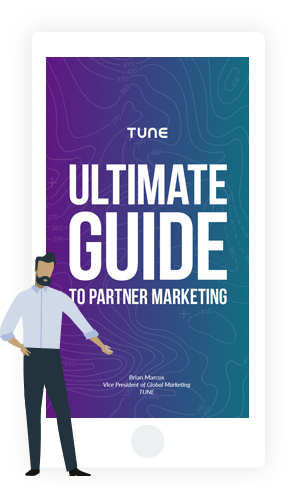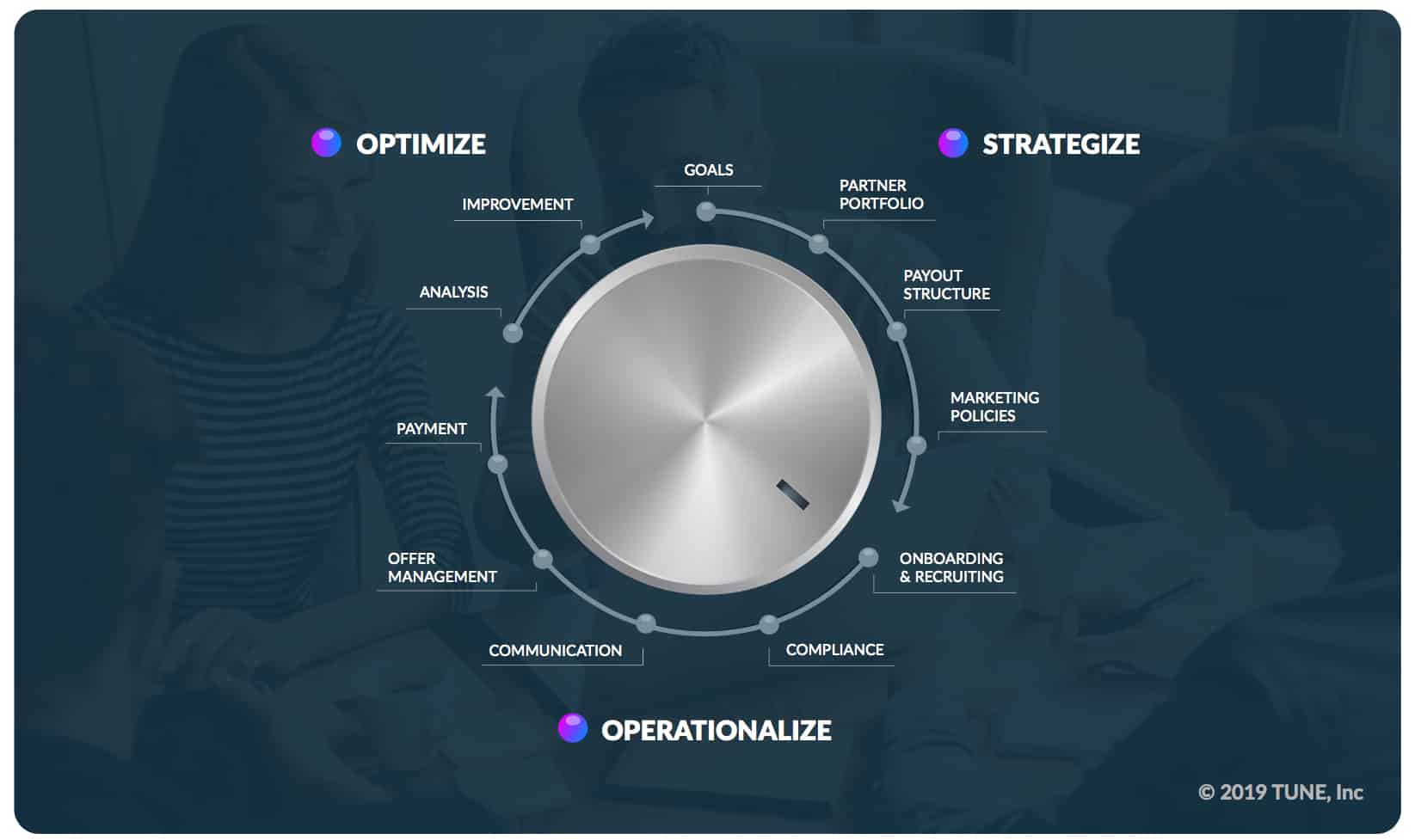Welcome to Part 3 of our Ultimate Guide to Partner Marketing series! In this series, we are exploring strategies found in The Ultimate Guide to Partner Marketing and bringing them to life through modern brands and use cases. If you’re just discovering the series, head over to Part 1 and Part 2 first.
So far, we’ve covered how to plan out a winning strategy for a partner marketing program. In this third post, we’ll focus on how to build it, starting with recruiting partners and onboarding them to your program. We will also take a look at recruiting tips from some of the world’s top employment companies and how you can apply them to your partner program.
From Partnership Plans to Program Actions
Now that you know how to plan a partner program, it’s time to go out and build it. Up next in the TUNE In Framework is the Operationalize section, which covers how to translate strategic marketing ideas into real partnerships and results.
Before you can see any results, however, you need marketing partners (like influencers and affiliates) to bring them in. That’s why our first order of business is to explore ways to successfully recruit and onboard new partners.
The Partner Recruitment and Onboarding Process
Attracting the right kinds of partners and engaging them in a program takes time, strategic thinking, and more than a little elbow grease. We recommend breaking down your recruitment strategy into four phases.
Each recruiting phase is designed to cover essential program elements and minimize partner-related risks. And while these phases are generally time-consuming, it is better to make the effort now to secure quality partnerships and a diverse program, rather than waste time later vetting poorly-matched candidates and optimizing sub-par performance.
The four phases are as follows:
- Phase I: Set partner approval criteria.
Thoughtful approval criteria attract the right kinds of partners, right away. Be sure to incorporate your marketing policies into the sign-up process, and require partners to accept them in order to be approved for your program. - Phase II: Build the foundation of your partner portfolio.
In many partner programs, 20% of the partners drive 80% of the revenue. This phase is about securing that 20%. Craft a pitch, share a clear value proposition, and show how your program benefits the partner’s business. Personalization is key here. - Phase III: Find and fill gaps in partner coverage.
Are there partners who are not in your program and are driving results for your competition? Research what it takes to make and keep these partnerships, and then reach out on a one-to-one basis to start a conversation about why they should be working with you. - Phase IV: Identify partners who climb the charts.
Monitoring your program for top performers and rising stars is an ongoing effort. In addition to keeping top partnerships happy, look for opportunities to nurture those on the rise. Often, these partners need only a little nudge to reach their full potential.
As always, you can find more information, including additional partner recruitment best practices and onboarding tips and tricks, in our free Ultimate Guide to Partner Marketing.
Best Practices for Recruiting Partners
When it comes to tried-and-true advice for recruiting affiliates and marketing partners, why not trust the experts? The LinkedIns, Indeeds, and Monsters of the world have proven that certain recruiting strategies lead to success, no matter the industry or position. The same goes for marketing partnerships. (Sometimes, the obvious answer is the right one.)
Let’s take a page from the books of leading employment-centric brands, job boards, and career professionals on recruiting best practices. LinkedIn, for example, suggests the following to complement their data-driven approach to recruiting:
- Look beyond the obvious candidates and sources. (In other words, find out where the talent is, and search there for similar partners.)
- Leverage technology to reduce friction points.
- Emphasize what candidates want to know. (Share information up front to answer the questions that are most important to your partners, and not just the questions you want them to ask.)
- Be clear and concise.
- Remember mobile device users. (Partners are all about optimizing experiences and performance; if you disappoint them in a key area, such as mobile offers for Instagram influencers, your partnership may end before it even begins.)
- Consider career paths and growth opportunities. (Communicate to potential partners how your program will benefit them — the goal is to build a mutually beneficial business partnership, after all.)
Recruiting Niche Partners
For more niche programs, it’s wise to look to the brands that serve niche audiences, such as TUNE customer FlexJobs.
FlexJobs provides an online job board specifically for part-time, gig, and freelance work. They also connect businesses looking to fill these specialized roles with the individuals searching for them. When it comes to recruiting, tips from FlexJobs apply just as well to affiliates and marketing partners as they do to gig economy workers.
For example, this advice from an article on recruiting for flexible jobs:
- Be specific.
- Know who you’re looking for.
- Know where to look.
Simple, but vital tips when searching for partnerships that will help to grow a program instead of taking your time away from it. Here are a few more recruiting words of wisdom from FlexJobs that hit the partner marketing nail on the head:
- Every interaction with a company (or a partner) is a reflection of you (and your program).
- Be consistent across your (program) brand.
- Mind your (partner) correspondence.
- Slow and steady does not win the race (when it comes to onboarding).
But perhaps the best advice of all is this: Think as a partner thinks. If you understand what drives your marketing partners, you will be better equipped to meet their needs and motivations. Even a small insight can lead to better relationships and do wonders to set a program on the path to success.
Next Up: Talking the Talk and Walking the Walk
With partner recruiting and onboarding in the bag, we are ready to move on to communication and compliance. We’ll cover the most important elements of a partner communication strategy, methods for enforcing compliance without alienating partners, and examples of programs that are excelling at both. Check back in two weeks for our next installment!
What is your biggest challenge in recruiting or onboarding partners? How have you solved it? Let us know in the comments below!
If you’re ready for your own partner program, get started by requesting a consultation with a TUNE expert.

Learn how to plan, build, and grow cross-channel partner programs with our Ultimate Guide to Partner Marketing series. Follow along as we introduce strategies from the Ultimate Guide and bring them to life through leading brands and advertisers.
- Part 1 – Planning Your Partner Program Strategy
- Part 2 – Determining Partner Payouts and Marketing Policies
- Part 3 – Recruiting and Onboarding Partners
- Part 4 – Communicating for Partner Compliance
- Part 5 – Managing Partner Offers
- Part 6 – Partner Payments
- Part 7 – Program Analysis and Optimization
Author
Becky is the Senior Content Marketing Manager at TUNE. Before TUNE, she handled content strategy and marketing communications at several tech startups in the Bay Area. Becky received her bachelor's degree in English from Wake Forest University. After a decade in San Francisco and Seattle, she has returned home to Charleston, SC, where you can find her strolling through Hampton Park with her pup and enjoying the simple things in life.




![Perform[cb] TUNE Partner Spotlight for June](https://www.tune.com/wp-content/uploads/2023/06/2023-Connect-Partner-Spotlight-Performcb-540x300.png)
Leave a Reply
You must be logged in to post a comment.